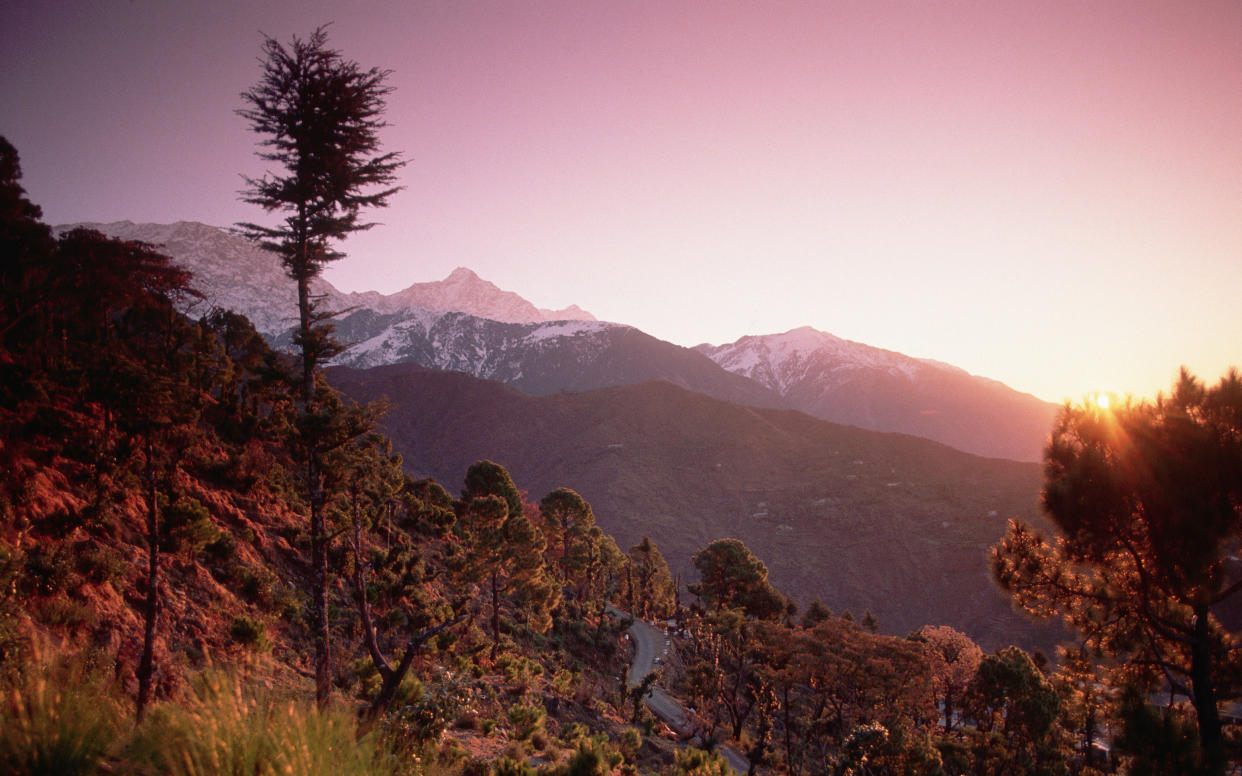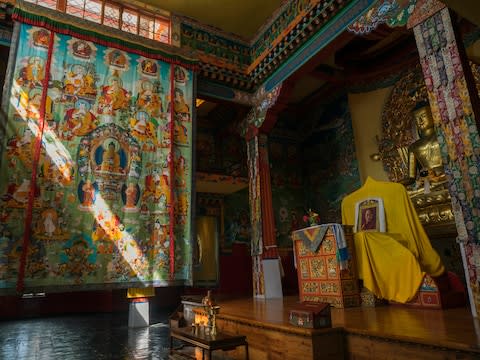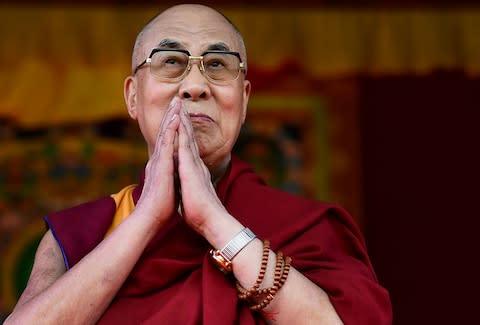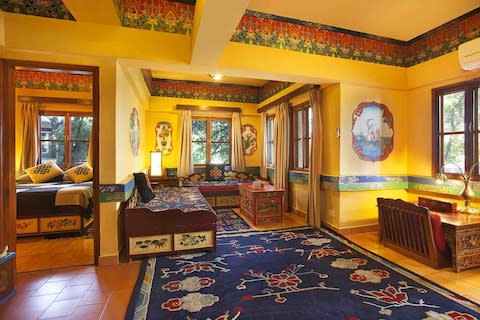What it's like to spend Christmas in Dharamsala, home of the Dalai Lama

The church was packed for the Christmas morning service – every seat taken, standing room only. Scores of people jostled for space at the back and spilt out of the doors. Across from the crib, the choir launched O Come All Ye Faithful – Indian-style.
They sang in Hindi with a catchy lilt – penetrating voices accompanied by tabla (Indian drums) and tambourines. Some of the congregation clapped along. Outside, snow-capped mountains glistened on the horizon. Huddled in shawls, my wife and I were having an unconventional Christmas more than 5,000ft up in the Himalayan foothills.
We were in Dharamsala, the former British hill station 250 miles (402km) north of Delhi. It’s now best-known as the home of the Dalai Lama, a centre for Buddhism, so it offered a novel take on one of the most Christian festivals.
Before the church service, “Little Tibet”, as Dharamsala is sometimes called, had seemed a largely Christmas-free zone. There were fluttering prayer flags instead of strings of fairy lights, chanting monks instead of carols, momos – South Asian dumplings – instead of turkey. We did, however, meet Father Christmas, if not (this time round) the Dalai Lama.
His Holiness – or “His Holliness” as a misprint on a local website seasonally put it – has been based here, with his government-in-exile, since 1960, a year after fleeing Chinese-occupied Tibet. Twenty years ago, on a previous visit, we interviewed him at his private residence.

It was a predictably memorable half-hour, full of his compassionate charisma, the sense of warm well-being he creates, and his seismically cheerful laughter. It’s not every day that you have tea and biscuits with a living god.
The interview coincided with Tibetan New Year, whose celebrations – generally in February or early March – were a dazzling display of exotic “otherness”. Smoke from bonfires of juniper branches wreathed across the hillsides. Monk-musicians in plumed yellow hats blew fanfares on conch-shell horns. Venerable women with faces like creased leather chimed bells and twirled creaking prayer wheels.

Young men whirled and stamped their way through ritual dances. At sunset, the mountains glowed pink and seemed to float on purple clouds. New Year’s Eve in Britain doesn’t quite match up.
Two decades ago, Dharamsala was a last outpost of dreadlocked hippies jingle-jangling their way around India in bandannas and tie-dyed shirts. They ate banana pancakes, listened to Grateful Dead cassettes, and analysed their inner consciousness and the state of their bowels (and smoked this and that). It was Nirvana-Nirvana Land.
These truth-seekers have mostly moved on, but backpackers still come here, says our guide Sanjay Kumar as, two days before Christmas, we drive up from the plains. He points out a new international cricket stadium in the distance – “so there are many more tourists”.
We stop at the Norbulingka Institute, a peaceful, vibrantly colourful centre for Tibetan culture with a temple dominated by a huge and inscrutable brass Buddha. There’s a doll museum, which doesn’t sound very promising, but its authentically costumed figures – the oracle, the holy hermit, the sorcerer – are an absorbing introduction to the intricacies of Tibetan belief.
In the workshops, craftsmen and women are embroidering, woodcarving, making copper Buddhas, creating thangkas – Buddhist paintings on cotton or silk. “It’s a sort of meditation; you need patience,” says Sanjay. A notice is pinned up next to one work bench: “The time to be happy is now. The place to be happy is here.”
Up hairpin bends, and then further up, is McLeod Ganj, the focal point for Tibetans, tourists and burgundy-robed Buddhist monks. It’s far busier than when we were last here. New hotels and restaurants have proliferated. A straggling bazaar offers endless lucky birth stones, singing bowls, pashminas, bangles and papier-mâché elephants. It may risk becoming a trinket town, but it still holds huge fascination.
What Christmas dinner looks like in 20 countries around the world
In the main square, Nowrojees store is a poignant reminder of the old days. This “Wine and General Merchant” opened in 1860, when McLeod Ganj was just a few huts and a lot of snow. The shop’s dusty shelves are now largely empty, except for Thirties and Forties cardboard and tin-plate adverts for Andrews Liver Salts, Rowntree’s Extra Creamy Milk Chocolate and Calvert’s Carbolic Medical Soap – staple requirements for colonials in plus-fours and pith helmets.
“Has the shop closed?” I ask a neighbouring trader. “It looks closed but it’s not,” he says. “Though there is nothing to buy.” I nod thoughtfully at this tantric paradox.
Dharamsala offers only the occasional hint of Christmas. One hotel has a decorated tree in its foyer, alongside a Buddha. A bookshop has a small stack of cards, mainly for visiting Westerners. There’s the odd festive window display. Christmas Day is a public holiday here, but no one makes much fuss.
Will anything happen on the day itself? “Santa will be roaming on Christmas morning,” Bhardwaj Dixit, manager of the Asian Plaza hotel assures us. “He will distribute sweets to children. It’s an English tradition.”
We’re staying at Chonor House, a delightful and welcoming Tibetan-style hotel run by the Norbulingka Institute. Rooms are decorated with specially painted murals (tigers and leopards prowl our walls) and after dinner we discover two hot water bottles thoughtfully slipped into our bed. During the night we hear distant chanting monks.

It prepares us for the Kalachakra Temple, which we visit on Christmas Eve. Framed photographs of the Dalai Lama are surrounded by twinkling fairy lights. Unexpected offerings are left in front of a mural of the Buddhist birth-to-death cycle: jars of honey, cans of sliced pineapple, tubs of cheese spread. Outside, an elderly woman is doing devotional prostrations, throwing herself to the ground and stretching full-length time and time again.
The nearby Tibet Museum gives a harrowing account of the experiences of the 150,000-plus Tibetans who have followed the Dalai Lama into exile. They tell stories of escaping torture by struggling through mountain passes in swirling snowstorms.
“When we reached Dharamsala we were taken for an audience with His Holiness,” says one. “I cannot remember anything that happened then. I just cried.” Another comments: “China is actively engaged in denials of our history and culture – our very identity. Time is indeed running out for our civilisation.”
Steve McCurry's India
We visit the Tibetan Handicrafts Centre, where women are weaving carpets, then drive a few miles out of town to the hill village of Naddi. Sanjay leads us along winding paths and trails, past terraced fields of wheat and barley. Women knit on their verandas or gather nettles and cultivated mustard to use in soups. Misty mountains loom behind them. In the high keen air, it’s wonderfully peaceful.
The next morning, we exchange “Merry Christmas” greetings with fellow hotel guests and head for the service at St John in the Wilderness church, with its old British memorials (including one to the Victorian viceroy Lord Elgin and another to a man killed by a bear). A scary Father Christmas with an impish mask and scarlet-painted nails is handing out sweets. People take selfies with “him”.
Sitting halfway back in the church is Professor M Alexander, a retired American academic who’s reluctant to give his first name. “My dear, I have lived here longer than I care to remember,” he says.
We talk about Dharamsala’s old hippy days. They aren’t quite over, he reveals. “There are people ensconced here who have been hibernating in little holes for years,” he says. “Indeed some have ‘gone native’… I have fresh bread here if you’d like it; fresh bread from the oven.”
Across the aisle, Mark, an American visitor, adds: “Hippies from the Sixties have evolved into the new establishment. People who smoked pot have become chief executive officers now.” Is he Christian? Buddhist? “I have no faith,” he says. “I feel I’m reincarnated from Carthaginians.”
It’s Christmas. But not as we generally know it.
The essentials
Cox & Kings (020 3642 0861; coxandkings.co.uk) has a 13-day/11-night journey through the Himalayan Foothills escorted tour from £1,925 per person, including flights, transfers, sightseeing and accommodation with breakfast and some other meals. The tour features visits to Dharamsala, Shimla, Amritsar, Chandigarh and Delhi.
Before heading for Dharamsala, the writer stayed at the LaLiT New Delhi (thelalit.com). It has stylish rooms, a range of restaurants and five-star facilities, including a gym, pool and spa. Doubles from 10,300 rupees (£120) including breakfast. For details, or to book, see telegraph.co.uk/tt-lalitdelhi. For more details see incredibleindia.org

